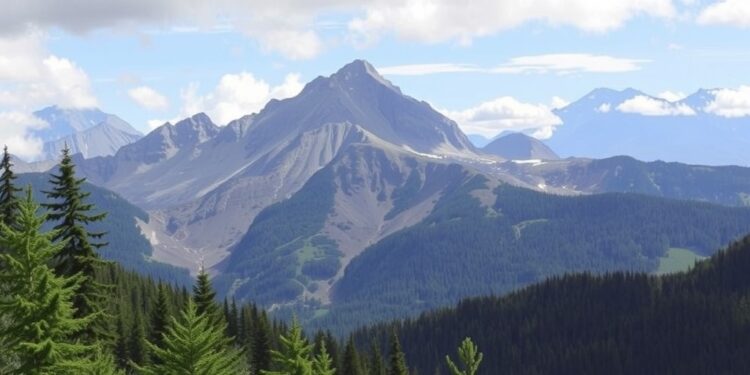Rising mountains do more than just alter the physical landscape; they also play a crucial role in driving evolutionary processes, profoundly impacting biodiversity on Earth. Recent research highlights this intricate relationship, revealing how tectonic uplift can be a significant factor influencing the diversity of species across vast timescales. The study offers unprecedented insights into the mechanisms by which mountain formation shapes ecological communities, yet underscores that many questions remain regarding the evolutionary pathways involved.
Mountain ranges are often celebrated as some of the most critical hotspots for biodiversity globally. Although they occupy only a small fraction of the Earth’s surface, their elevation and geographic features create unique environments that foster a rich tapestry of life. The connection between mountainous terrain and species diversity is profound, suggesting that evolutionary pressures tied to topographical changes are key drivers of the richness we see today.
Research conducted by Eyal Marder and colleagues explores the role of mountain building in biodiversity through advanced modeling techniques. By simulating millions of years of geological uplift, the researchers were able to investigate how various rates of mountain formation impact species richness. The model utilized a biologically simplified speciation algorithm coupled with landscape dynamics, allowing researchers to replicate realistic scenarios of tectonic uplift over extensive periods. This not only sheds light on the overall patterns of biodiversity but also demonstrates the far-reaching impacts of geological processes.
One of the primary findings from Marder et al.’s study is that tectonic and geomorphological activities intricately shape not only the high-elevation mountain regions but also have measurable effects on adjacent lowland ecosystems. These findings challenge the conventional understanding of biodiversity distribution, indicating that even regions typically considered low in species richness can exhibit trends that mirror their mountainous counterparts. Such insights are crucial for conservation efforts, emphasizing the need to consider how changes in topography due to tectonic activities can influence biodiversity across whole landscapes.
Interestingly, the research also indicates that species richness tends to increase in direct correlation with both the magnitude and the pace of mountain building. As mountains rise, they create new habitats, niches, and opportunities for speciation, which can lead to an explosion of diverse life forms over time. However, Marder et al. highlight a significant delay in the response of species richness to the onset of mountain building. It appears that diversity does not instantaneously surge with the emergence of new terrain; rather, it stabilizes and reaches equilibrium only after the topography has settled and the evolving landscape allows populations to adapt and thrive.
The dynamics of population isolation play a pivotal role in this evolutionary drama. Erosional highlands, often characterized by their rugged and fragmented landscapes, may lead to increased levels of isolation among species. This isolation is a crucial factor for speciation, as it allows for genetic divergence to occur among populations that become cut off from one another. Over time, evolutionary pressures such as natural selection and genetic drift can further enhance this divergence, leading to the emergence of new species adapted to their specific environments.
Moreover, the study identifies significant correlations between the biodiversity dynamics of highlands and lowlands. This interconnectedness suggests a broader ecological framework where mountain-building processes not only redefine the heights of landscapes but also influence the dynamics of biotic communities living in the proximity of these ranges. The authors argue that such findings underscore the importance of viewing biodiversity through the lens of ecological and geological interactions, highlighting the necessity of integrating multiple scientific disciplines when studying the complex tapestry of life on Earth.
Overall, Marder et al.’s research enhances our understanding of the intricate relationship between geological processes and biodiversity. Their findings point to a crucial need for ongoing research to elucidate the mechanisms behind these patterns further. As we continue to confront global changes driven by climate, tectonics, and human activity, understanding how these factors influence biodiversity will be fundamental to effective conservation and management strategies.
By revealing the more significant implications of mountain uplift, this study has great potential to influence how we view ecological dynamics in mountainous regions. The research encourages scientists and conservationists alike to reconsider the role of geological change in shaping life on Earth. It emphasizes the need for a holistic perspective when examining biodiversity patterns, acknowledging that mountainous terrains are not just mere backdrops to ecological scenarios but active participants in the story of life’s evolution.
In conclusion, as we stand on the precipice of significant environmental changes, understanding the intertwining of geological uplift and biodiversity is more critical than ever. The work of Marder and colleagues paves the way for future investigations into how evolutionary trajectories are shaped by the Earth’s dynamic forces. Their findings remind us of the rich history held within our planet’s landscapes and the intricate pathways that lead to the wondrous diversity of life inhabiting them today.
Subject of Research: Mountain uplift and its effects on biodiversity
Article Title: Direct effects of mountain uplift and topography on biodiversity
News Publication Date: 21-Mar-2025
Web References: http://dx.doi.org/10.1126/science.adp7290
References: [Not available in the text provided]
Image Credits: [Not available in the text provided]
Keywords: mountain building, biodiversity, tectonic uplift, evolutionary change, geographical features, species richness, ecological dynamics, geological processes, conservation, ecological communities.




